Many users cropped cameras often complain that it’s difficult to get a good picture from such a camera and that you must use full frame. Many people just drool on full-frame camerasthinking that they can do something improve their photos. And if you really want to shoot a full frame, and at the same time invest a little bag of money to purchase a camera, then this article is just for you.
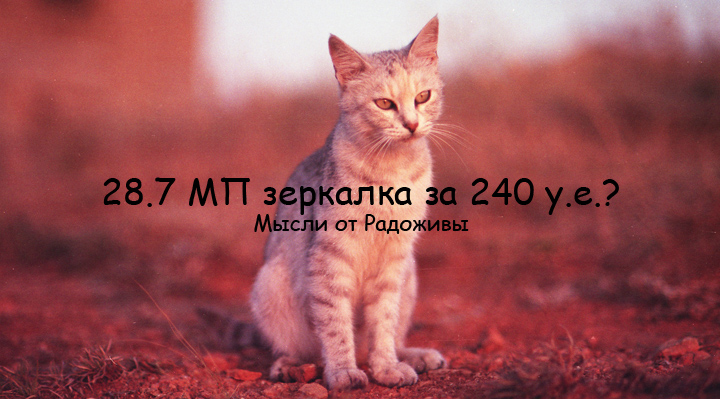
Shot on the same Full Frame :) 28 MP for 240 cu The cat is photographed in the sunset red sun.
Any good photography is based on the desire and skill of the photographer, everything else (including photographic equipment) is just a distraction from the main goal. I am often reproached for advocating to shoot with cheap equipment. I don’t actually do that, I advocate the idea that you can get a good shot from any camera if you want. Of course, the better the technique, the easier and faster the result can be achieved. Those who want to get good pictures get them from anyone, sometimes even the cheapest technique.
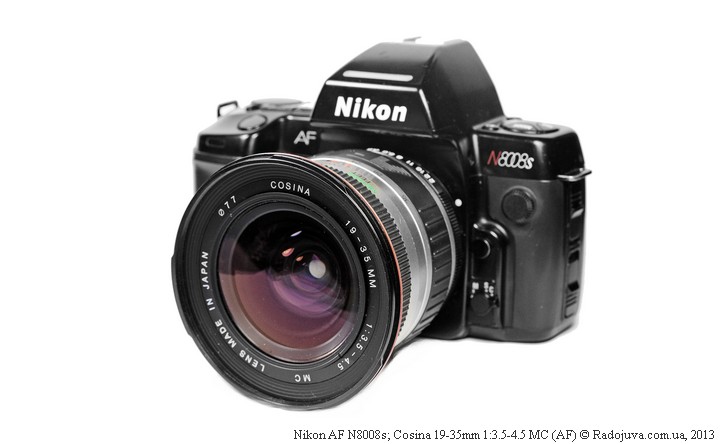
Actually, in this photo almost the whole essence of the article :)
Therefore, if there is a key aspect - desire, then for only 240 cu can:
Shoot with a full-frame SLR camera, with fast automatic focus, good serial shooting with a huge frame buffer, a huge optical viewfinder, nice controls and at the same time take pictures at 28 MP.
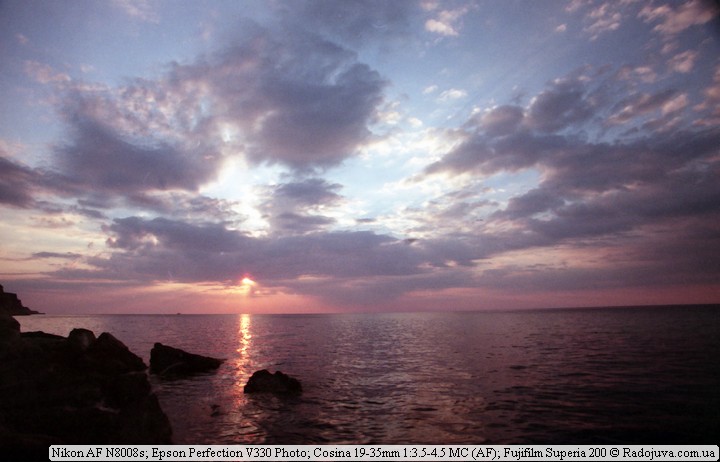
Example photo on my set. Sunset.
The secret is very simple - just use a film camera.
Many readers may think that the film camera is something terribly ancient, incomprehensible to manage, morally obsolete and unsuitable for use in the era of modern monsters Nikon D4 and Canon 1DX. In the expanses of the CIS countries such an impression people have it from the fact that in the Union and on its territory not a single SLR narrow-camera camera with automatic focus was released. Seriously, the old Zeniths do not cause any interest among young people, the main reason for which is the complete obsolescence of technology.
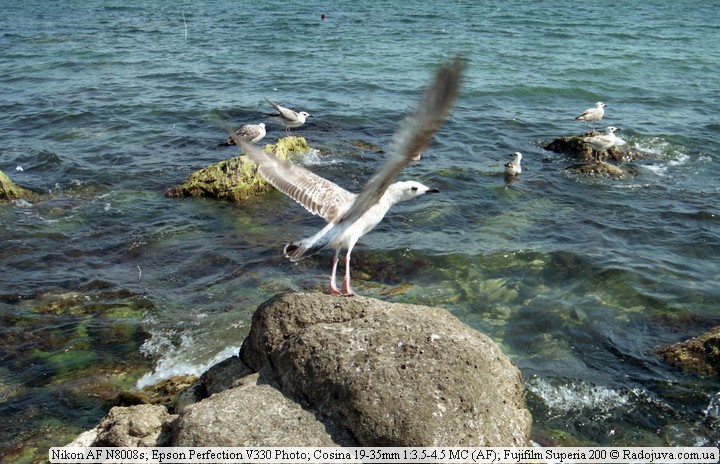
Example photo on my set. Gull
But in other countries long ago let out pretty autofocus analog volatile DSLRs with interchangeable lenses. Moreover, using such a SLR camera is no different from any modern amateur DSLR camera. Nikon D3200 or Canon 600D.
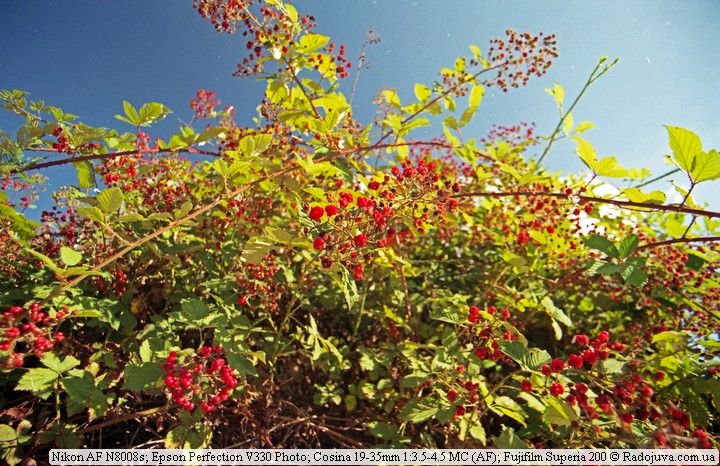
Example photo on my set. Forest Blackberry
I conducted an experiment, which cost me quite inexpensively, as a result of which this kit was assembled here:
- Nikon AF N8008s (also known as Nikon AF F801s) - 400 UAH
- Cosina MC 19-35mm 1: 3.5-4.5 (AF) - 700 UAH
- AA Batteries * 4 - 20 UAH
- 200-frame Fujifilm Superia 36 film roller - 27 UAH with free development
- Epson Perfection V330 Photo Scanner - 650 UAH
- Shipping of the camera, lens and scanner - 80 UAH
Total 1877 UAH or 235 cu In fact, I could save on the lens and batteries, since I have both. The camera, film roll and scanner cost me some 140 cu
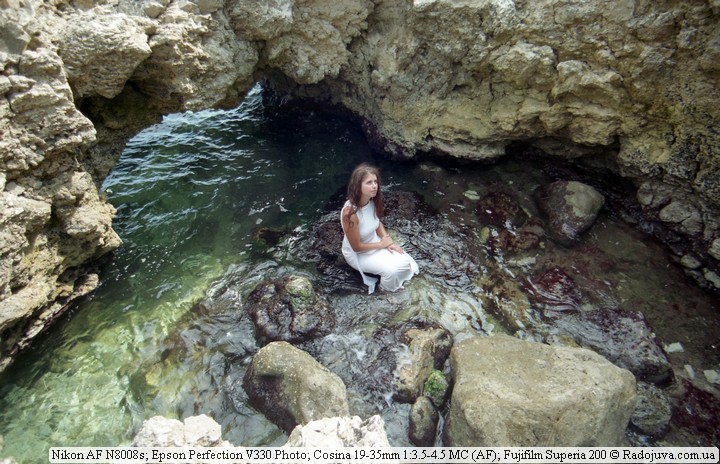
Example photo on my set. Among the stones
As a result, I got:
- A full-frame camera with a shooting speed of 3.3 frames per second. Some amateur cameras have approximately the same shooting speed. Nikon D80, D70s, D3000, D3100, and some professional CZK for 500 cu they shoot even slower, for example, Fujifilm Finepix S5 Pro.
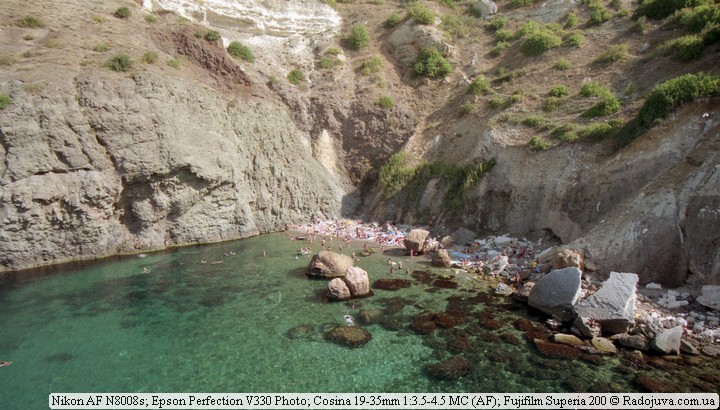
An example of a photo on a film camera. Beach.
- Maximum frame buffer makes 36 shots, for example, Nikon D7100 with the highest quality has frame buffer only 6 shots (RAW, 14-bit, lossless compression).
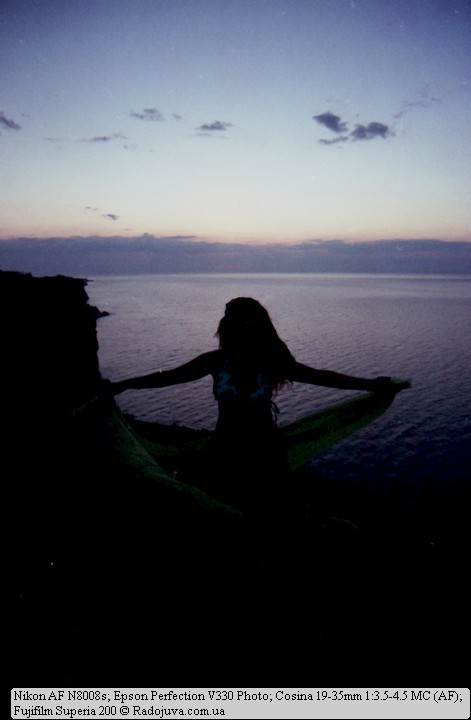
An example of a photo on a film camera. After sunset
- My camera can work out super short shutter speed equal to 1/8000 seconds, which even can not Nikon D600 и Canon 6D.
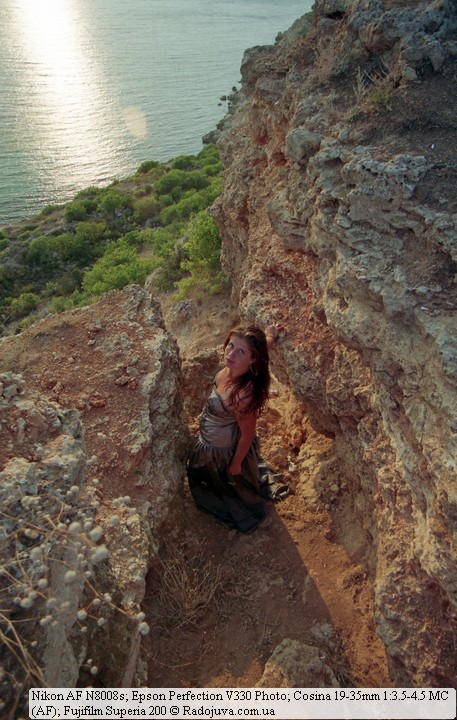
Example photo on my set. Among the stones
- A huge optical viewfinder that never dreamed Canon 70D for 1500 cu Yes, and in itself Nikon AF N8008s very good and durable camera.
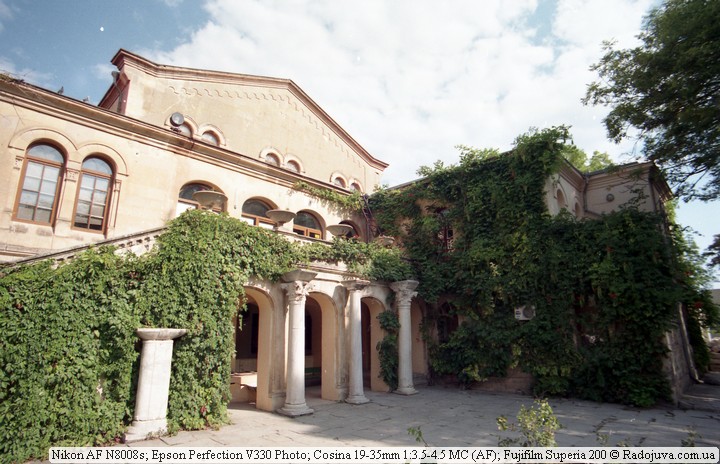
An example of a photo on a film camera. House overgrown with grapes.
- My Nikon AF N8008s it works easily with manual optics - it correctly measures exposure, has an electronic range finder, which very accurately tells about focusing. Even Nikon D5200 for 600 cu can't measure exposure with AI-S lenses.
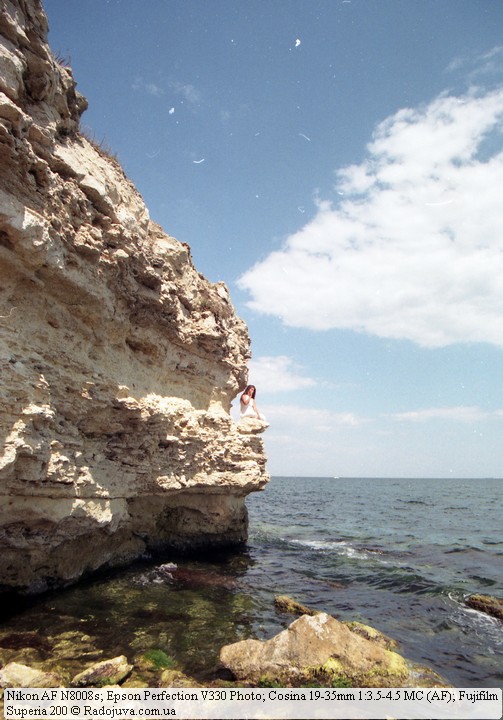
An example of a photo on a film camera. Sitting on the rocks.
- Very nice LCD in JVI, its brightness is physically (not electronically) dependent on the light source. The brighter the source - the brighter the LCD, which allows you to always clearly see the camera settings in JVI. For example, on many CZKs, I don’t see the LCD at all on a bright day or when shooting in backlight.
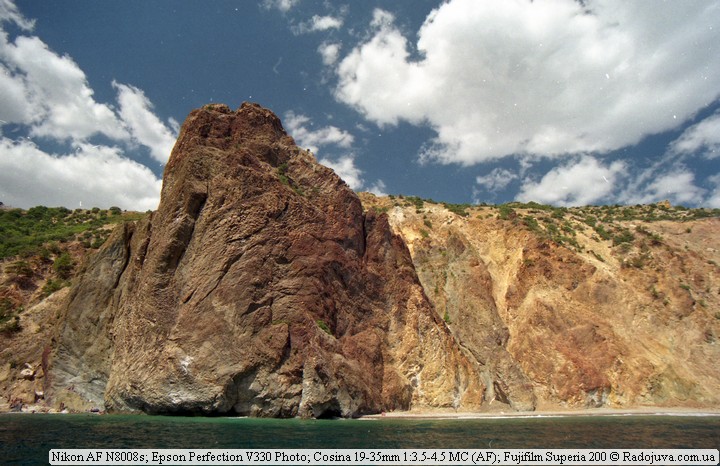
Example photo on my set. Photo from the boat
- Camera control is almost the same as that of any other Nikon CZK. When shooting, you don’t feel any difference, the whole setup is on a monochrome display.
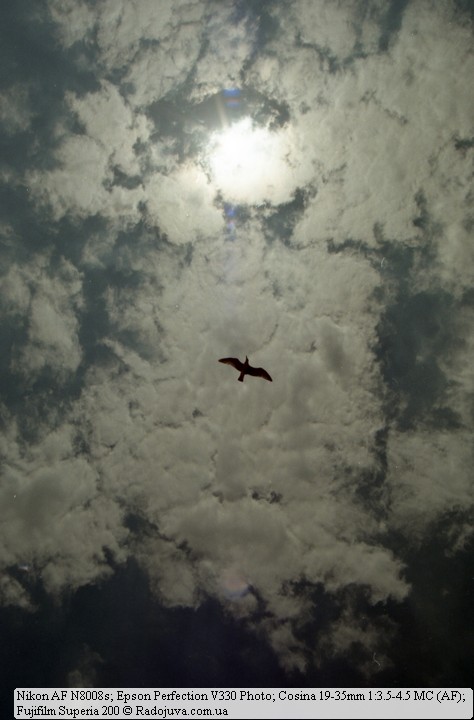
An example of a photo on a film camera. Gull
- Lens Cosina MC AF 19-35mm 1: 3.5-4.5 I just bought it for fun. 19mm at full frame can be safely attributed to an ultra-wide range of focal lengths. The lens focuses terribly fast, and with it you can create amazing pictures. To get the same viewing angle as this cheap lens gives out, on Nikon cropped cameras you should use the expensive Nikon 12-24mm F / 4.0.
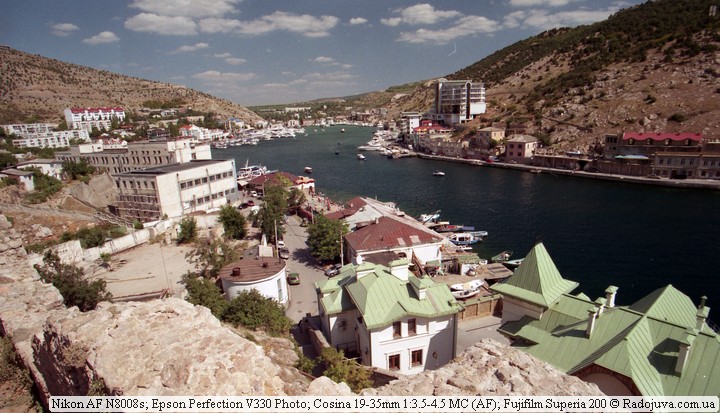
Example photo on a film camera
- A scanner in the house is also useful, for example, to digitize old photographs for an album. For example, you can scan your school diaries, and share old memories on social networks. In any case, the scanner will not be redundant.
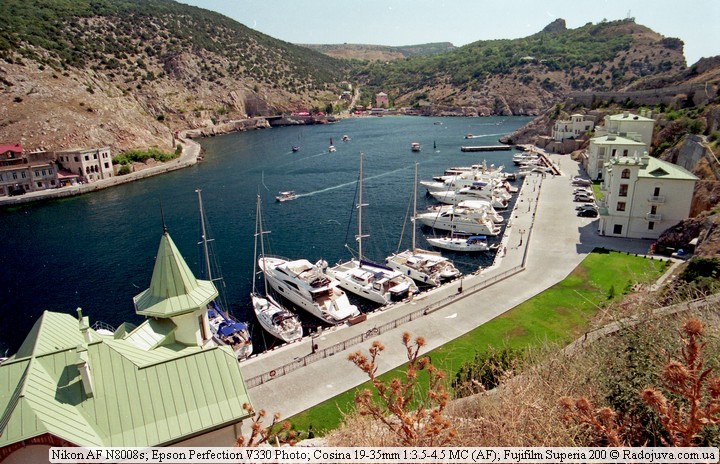
Example photo on my set. Yachts
- The scanner allows you to obtain images with 48-bit color depth. This means that each channel is encoded with 16 bits. Most 'cool modern cameras'can encode a channel using only 14 bits, and receive 42 bits at the output. Theoretically, with my scanner, you can get 64 times more shades than with any DCC.
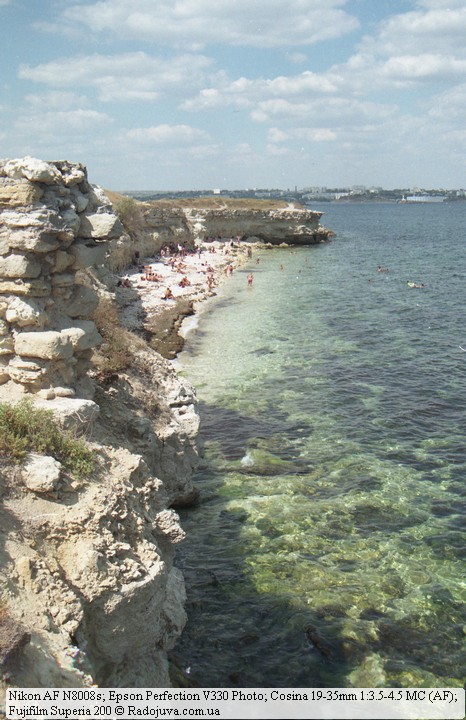
An example of a photo on a film camera. Shore
- Of course, my set has more disadvantages than advantages :), but I’ll keep silent about them in this article.
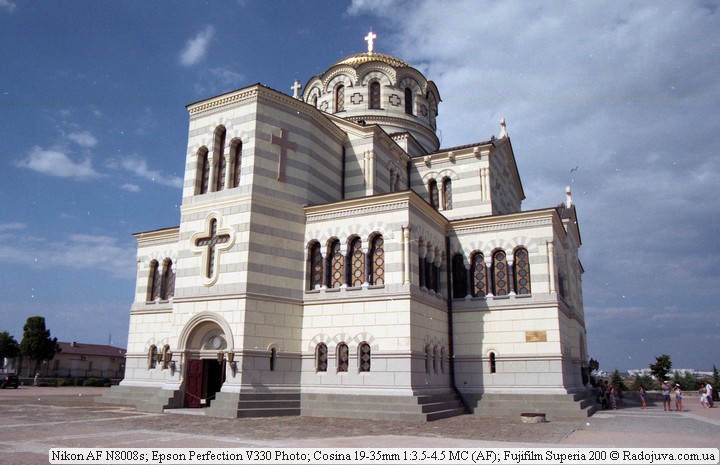
Example photo on my set. Temple in Chersonesos.
The following describes where I got 28 MP from the old film camera.
Of course, the 28MP figure in the article is a duck. But you can still get this figure in this way - the film has a physical frame size of 24mm * 36mm. Let's find the area of the film in square inches, since the parameters of the scanner are indicated in inches.
1 centimeter = 0.393700787 inches
1 square centimeter = 0.15500031000062 frame inches
1 square centimeter = 100 square millimeters
1 square millimeter = 0.0015500031000062 cpi
As a result, the film area is24mm * 36mm * 0.0015500031000062 = 1,339202678405357 sq. inch
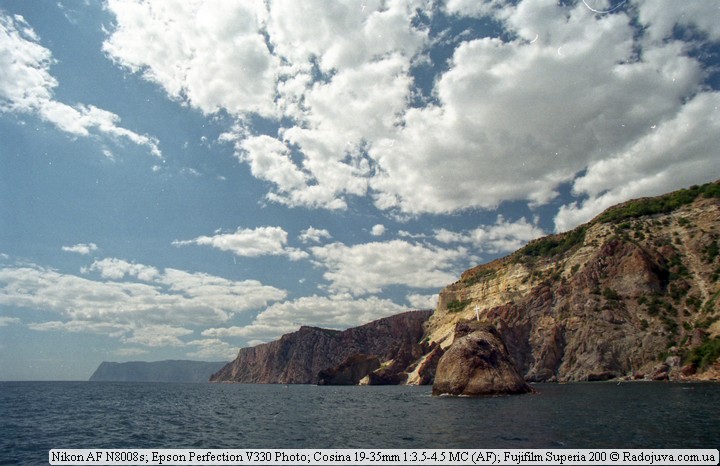
Example photo on my set. Landscape
The area of the film is 1,339202678405357 sq. inches. My scanner scans at 4800 pixels per inch, or 23 pixels per square inch. From 040 square inches of 000 pixels per square inch, 1,339202678405357 23 040 pixels are obtained, which is approximately equal to 000MP.
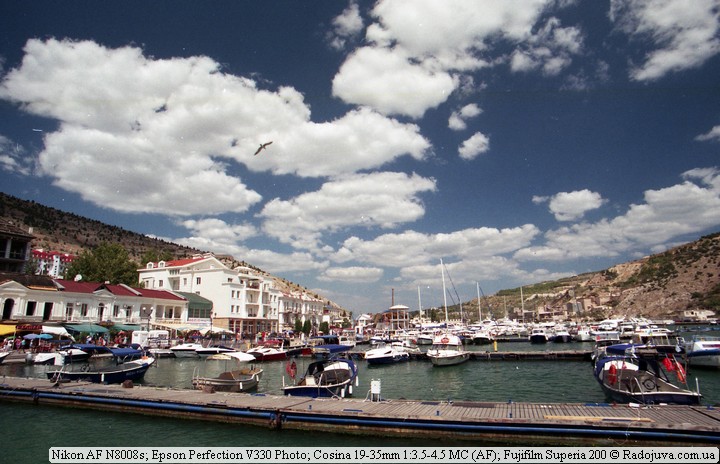
Example photo on my set. Balaclava
If your scanner has a different DPI, then the number of pixels when scanning a film frame can be calculated using the following simple formula:
DPI * DPI * 1,34
Some scanners in specifications have different DPI in height and width, for example, 4800 * 9600 is indicated in the specifications of my scanner. In fact, I can only scan at 4800 * 4800 or 9600 * 9600. The last option is half interpolation. The 'maximum possible DPI' is often indicated, for example 128000 is simply bloating the final image using a mathematical method of interpolating pixels, these numbers should not be paid attention to.
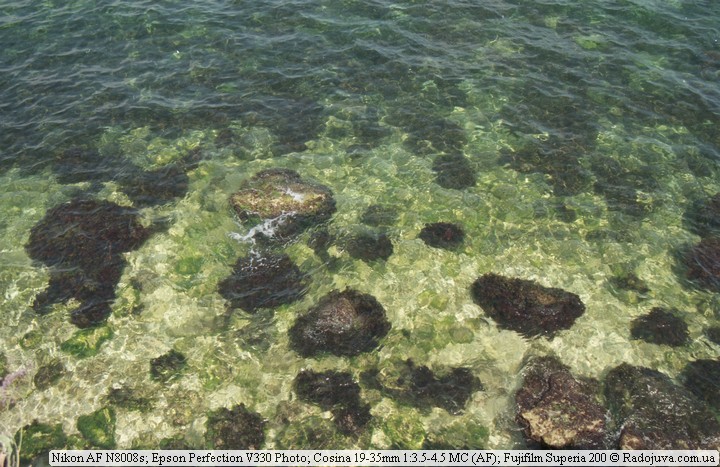
Example photo on my set. Near the shore
The simplest scanners with a slide adapter have 1200dpi, as a result, such a scanner can be squeezed out of one film shot:
1200 * 1200 * 1,34 = 1 929 600 (total about 2 MP)
I indicated '28MP camera' in the title of the article, since my Epson Perfection V330 Photo cuts off the edges of the frame a little when scanning and we end up with images not from the entire area of the film, but from a slightly smaller area. For example, a scanner often creates images like 6639 * 4319 pixels. Those who are chasing megapixels have already realized that from such a simple set you can squeeze these (or not these?) megapixels almost as much as Nikon D800 (a D800 costs almost 3000 cu).
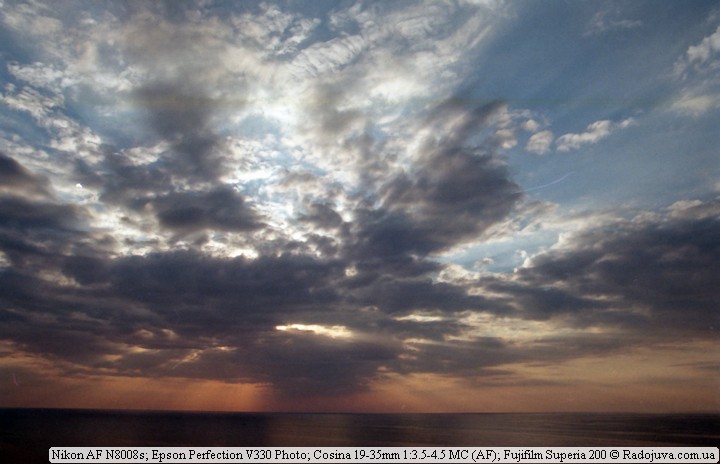
Example photo on my set. Another sunset
By itself, for serious work, such a set is no good. But the task before me was quite amateurish. For 240 cu I can enjoy a full-frame camera with convenient professional-grade control, an ultra-wide-angle lens that helped me out well on vacation and in addition I have a scanner that is convenient for scanning mail invoices :). I do not advocate fussing with a film camera, but once again I want to emphasize that there is absolutely no difficulty in working with a good analog camera. And instead of being discouraged that someone full frame, you can easily and simply shoot a full frame yourself.
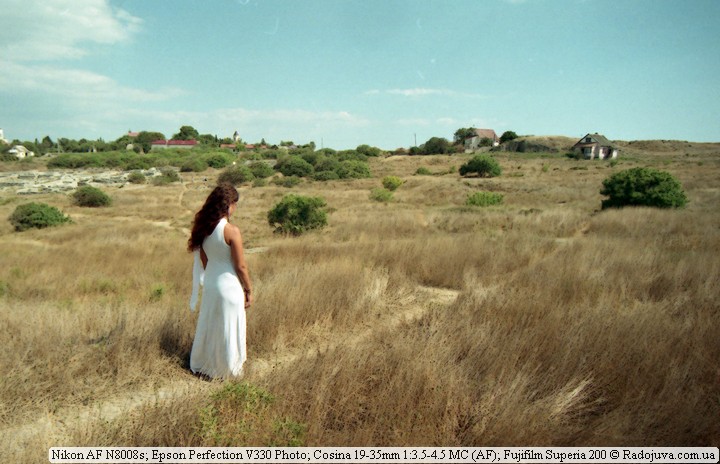
Example photo on my set. Road.
More sample photos (1400 pixels long)
Conclusions:
All of the above applies not only to my set. I brought my film set as real worldly example. Now buy used Nikon or Canon's autofocus analog camera is easy, the same goes for good-old lenses. The same story with the scanner.
Comments on this post do not require registration. Anyone can leave a comment. Many different photographic equipment can be found on AliExpress.
Material prepared Arkady Shapoval. Training/Consultations | Youtube | Facebook | Instagram | Twitter | Telegram















































I sometimes use all 16 exposures (very long, but extremely effective ...)
So I do not trust the numbers in the most special cases ... but I shoot everything on film all the weddings, discharge from the hospital, etc. and Nikon F80 copes with this perfectly, I'm just glad that I have it, for 10 years already, and during this time how many digits have passed and have sunk into oblivion, and it is and will be ... an excellent machine.
Fuji-fujifilm-s3pro is based on Nikon F80 (not at all ...).
Displaced light in rooms (incandescent lamps, light from windows and flashes ...) is a disaster for digital, but film is much easier ...
For many years, the weddings of the central registry office of Kiev were printed from “Reala” for my son (with excellent packaging with digital technology ...).
One target http://www.terrapinphoto.com/jmdavis/10D_scene-overview_resized_fernando.jpg For Canon 10D (increase to 122%) http://www.terrapinphoto.com/jmdavis/10D_512x512crop_fernando.jpg For Film scan Minolta 5400 (decrease to 50%) http://www.terrapinphoto.com/jmdavis/Velvia100F_DSE5400_1250x1250crop_fernando.jpg
And now a little to the side.
In general, TIFF (JPEG?) From these machines is good in quality.
For comparison: the Minilab NORITSU QSS 3201 and the desktop Konica Minolta DiMAGE Scan Elite 5400II
File of NORITSU QSS 3201 6774x 4492 87.0MB TIFF 8bit 79lin / mm
File for Minolta Elite 5400II 7651 × 5072 111MB TIFF 8bit 81 lines / mm
(resolution, in the center (pairs of lines), obtained from a makeshift test table based on the NSh3 scales, from the FUJI SUPERIA 100 film, foot NIKON F3, AF MICRO-NIKKOR 105 / 2.8D, f11,)
For NORITSU QSS 3201, noise reduction and Digital ICE work much better, there is no large spread in color. But at the same time, the picture is slightly flat, brighter and more contrasting, glare (on grass and leaves, for example) is less developed. At the same time, the file is well drawn in Photoshop in highlights and shadows, but it is still inferior to the Minolta Elite 5400II in working out the glare (with a small caveat - if the SilverFast program is used in Minolta, the native Minolta software tears light and shadows completely).
The Minolta Elite 5400II has the advantage of 16 bit color per channel, a more vivid picture, the ability to scan linear TIFF (RAW) with a completely removed mask, not stained or scratched films after the minilab. Worse than depth of field, uneven films have to be scanned twice with different focusing and then glued in Photoshop, much more time spent on color correction, Digital ICE removes long small (namely small) scratches and fingerprints worse. Due to the glare frame, yellow stripes are sometimes visible on the short sides of the frame (it is desirable to make the edges matte)
And yet, take a closer look at the 6x7 format (at least ...) http://album.foto.ru/photo/852760/ According to advertising from KALINICHENKO (scanning with a V-750 tablet is not ah, but already tolerable ...) It would be much better with a slide scanner (good print from 70x90 to 120x140 ...)
Comparison of digital equivalent and different types of films…. http://www.clarkvision.com/articles/film.vs.digital.1/index.html
Usual 35mm "two-hundred", scan by Viktor Lushnikov (5000ED) http://image.ayalla.ru/filmprocess/kodak_elitecolor200uc_001.jpg
Arkady, good evening, tell me if you have instructions for this unit?
No instructions.
Full instruction in aglitsky:
http://www.zavagli.it/Nikon%20F801S%20manuale%20inglese.pdf
35mm scan of Vadim Makarov (Nikon LS-2000) http://www.vad1.com/photo/stock/n54-17-4.jpg
35mm scan of Vadim Makarov (Kodak Photo CD lab in Norway) http://www.vad1.com/photo/stock/n22-2.html
I could not resist. At the expense of the grain on the film. You can also give a picture of Vrubel as an example. He has "grains" generally half a meter. And nothing, hangs in the Tretyakov Gallery ...
35mm slide http://image.ayalla.ru/filmprocess/fuji_velvia100f_001.jpg
When scanning a slide, a higher luminous flux of the scanner provokes a reflection in layers (with some loss of sharpness ...) With manual printing (with good optics ...) the sharpness is higher, but manual retouching is necessary (and there is a big problem with photo accessories for this printing ...).
Good afternoon, Arkady, tell me I have the same Nikon 8008s, what settings should I put in order to use Helios 81 with blowing on it? because as soon as I install it on the camera, it immediately goes dead.
Digit versus film (one of the many tests ...) http://photo.fxb.ru/digitfilm_result.html
Guys, tell the layman - which film should be: negative or slide? Or does the scanner care what to process, including the negative? Thanks in advance
The film is ordinary, to get negatives. A scanner can usually scan slides and negatives.
A greater dynamic range is removed from a slide and its grain is finer, but there are stricter requirements for the steepness of the scanner itself and it is still rare where it can be qualitatively developed ... In our conditions, negatives are often used (if you do not show it yourself ...).
Thanks. Those. all the same the scanner should be special, or will any modern, for example HP combined printer-scanner-fax, fit? In this case, will you need additional a program that scans negative? And will digital images from a negative be inherently better than scanned prints from regular photos? I mean, is it worth spending money on specials. "Photo scanner" to digitize a large number of old films ?? Thanks.
A conventional scanner is not good. A cheap flatbed scanner has a special slide adapter for scanning negatives and slides. When choosing, you need to pay attention to this adapter. And specialized scanners are very, very expensive.
To make a decision in accordance with your volume of work on archiving, it is not necessary to re-read the materials of this conference (then you definitely won't be mistaken ...) http://forum.ixbt.com/topic.cgi?id=20:7221 Do not pay attention to seemingly old dates - the best "hardware" according to current estimates was developed before 2004 .... Regarding the high cost of specialized slide scanners - I do not agree, you can fit in two hundred eared hedgehogs (a complete set of Nikon Super Coolscan 2000 ED only from the service, caught for 202ue ...), and its exact copy (though without multiple exposure and 10 bits instead of 12 ...) can be obtained even up to a hundred ye (though all this can work on Windows up to XP.
Wrongly wrote ED (Another name is Nikon Super Coolscan LS-2000, and the younger model is Nikon Coolscan III LS-30)
http://www.ebay.com/itm/Nikon-CoolScan-LS-50-V-ED-Slide-Film-Scanner-/190962451642?pt=US_Scanners&hash=item2c763fc4ba&forcev4exp=true I sealed the front panel and (fs f ...) By the way, all the missing pieces were in a separate plastic bag ...
Thanks a lot flueg for the info. I will think in this direction. Life goes on in a circle: film (slides) - paper - digital file - paper again. So maybe there is a truth in an old joke that the best information keeper is PAPER !!! :))
The best storage of information is a tape ... (if stored correctly). And the way of demonstration is according to personal preference.
Ksati, at one time I reshomed the negative onto the same negative film (with a microplanar ...) and the resulting slides (had commercial success ..., albeit with significantly lower DD, as after the “light and shadow” Photoshop tool), but the sharpness was completely preserved ...